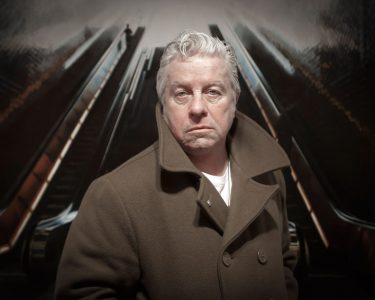One of Britain’s most influential photographers, Brian Griffin’s work has spanned many generations. He talked to Fergus Byrne.
At the opening of a new exhibition of some of his early work, photographer Brian Griffin looks slightly bemused at just how old some of the photographs really are. ‘There’s not an image on this wall that’s less than thirty-five years old’ he exclaims—an arm waving towards the many vintage prints that date from as far back as 1972. The exhibition, at the MMX Gallery in New Cross, is called Brian Griffin: Work and other stories and displays extraordinary silver gelatin framed prints including a ballroom dancer from 1972, and a 1974 image of the actor Simon Callow.
There are photographs from his corporate work in the early seventies, his visit to Moscow in 1974 and steelworkers in Broadgate in the mid-eighties, but what surprises many is the fact that his iconic photograph A Broken Frame taken at Saffron Walden for the cover of the Depeche Mode album of the same name is 37 years old. A unique vintage Cibachrome print, it’s available from the gallery for £6,800.
As selector for this year’s Marshwood Arts Awards, it is hard to find a more experienced photographer than Brian. The MMX Gallery exhibition also has signed copies of his book Brian Griffin Copyright 1978, which his close friend Martin Parr pointed out is the first self-published book by a photographer in the UK. Brian remembers how it came about: ‘There were no photo books around apart from, The World of Henri Cartier-Bresson and Bill Brandt’s Shadow of Light. It was just yearbooks—BJP yearbook, Photo yearbook, Zoom yearbook.’ He recalls seeing ‘wonderful pen and ink illustrations’ by the designer Barney Bubbles in the New Musical Express and wanting to work with him. They got together, and over a hazy afternoon in Brian’s flat developed the idea of using tiny, subtle line illustrations around some of Brian’s photographs. ‘I don’t know what made me feel so adventurous’ he says ‘because I wasn’t earning that much money then because I was doing editorial.’ He produced 500 copies, and very few of them sold at the time, but since then the book has become a collector’s item and sells for around £150.
He and Barney, whose legacy goes back to underground magazines such as Oz and IT became close friends. ‘He was like my brother’ says Brian. They worked together on many projects in the years to come until Barney sadly took his own life in 1983.
Growing up in the Black Country, Brian Griffin never really planned to become a photographer, but he did want to escape his job at British Steel. He compiled a rough photo album, ended up at Manchester Polytechnic, graduated with a diploma in 1972 and was soon commissioned to work for magazines like Management Today, Accountancy Age and Campaign. He had been hired by the late Roland Shenk, the design genius credited with transforming business-to-business publishing. Shenk once said that commissioning photographers like Brian Griffin was one of his “greatest achievements”.
As he was well experienced in photographing men in suits, when he took his portfolio to Dave Robinson, the one-time photographer who had helped set up Stiff Records, Brian was immediately assigned jobs to produce images for record covers. It was the post-punk New Romantic era, and there was no shortage of people dressing in smart suits for their debut albums. Brian’s first assignment, however, was to meet Graham Parker and find a way to photograph him looking like a gorilla. The result, shot near the Hayward Gallery on London’s South Bank, became the cover shot for The Parkerilla album.
The rest of Brian’s career in the record business reads like a who’s who of the music world. He photographed Nick Lowe, ‘He thought I was too arty and didn’t want to work with me’ and Peter Gabriel, ‘We didn’t work well together, although I must admit I was fond of him.’ Not much fazes Brian though, which was one of the reasons he could get such great shots. Peter Hamill from Van der Graaf Generator turned up with half a beard—he had shaved the left side of his face only, and Brian caught the idea perfectly.
Photographing Alex Harvey from the Alex Harvey band by the side of the Thames one day he turned away only to find Harvey—notorious for antics as wild as Keith Moon’s—had jumped into the river. ‘He ended up in Guy’s hospital as the Thames is so polluted!’
Album covers included Jona Lewie, ‘a true eccentric’ and Billy Idol, ‘I remember us bouncing around the studio like angels on pantomime wires’. For a Lena Lovich cover, he shot her as a silent movie star inside an empty stainless steel Guinness vat in the Park Royal brewery. He worked with Elvis Costello, Devo, Iggy Pop, Echo and the Bunnymen, Ultravox and The Teardrop Explodes. He shot single and album covers for David Essex, Kate Bush, The Stranglers, Chris De Burgh and The Psychedelic Furs.
One of his favourites was the cover for Depeche Mode’s Construction Time Again where he had the brother of one of his assistants standing on the side of a mountain in Switzerland wielding a massive sledgehammer. He was an ex-Royal Marine and ‘fit as a butcher’s dog’ said Brian. They even brought the sledgehammer from London to Switzerland where it landed on the luggage carousel with such a bang that customs men immediately descended on them. The final cover image, with the Matterhorn in the background, was breath-taking.
A photograph of Joe Jackson’s shoes for the cover of Look Sharp annoyed the singer because it didn’t show his face. He subsequently never worked with Brian again, but the shot is always in the top 100 album cover lists.
In 2017 he published one of the all-time great records of photography from the music industry during that era, with a book called simply POP. It includes photographs from all of the above as well as portraits of Vivienne Westwood, George Melly, Brian May, Queen, Bryan Ferry and George Martin—to name a few. Self-funded with a Kickstarter campaign, the book is one of more than twenty books of Brian’s photography. POP quickly sold out and is now hard to find at a decent price.
Other than a period from 1991 to 2003 when he concentrated on making films, TV commercials and music videos, Brian has consistently produced wonderfully creative photographs. However, he is acutely aware of the difficulty that success can bring. ‘The destructive element is success’ he says. ‘Success brings a lot of damage. I know for myself when I was very successful in the late 80s—I was the highest-paid photographer in Britain from about 85 to 91—it really was a destructive element.’ There was a point where clients exclaimed that he was ‘more expensive than David Bailey!’ But that didn’t stop them from hiring him. However, keeping his feet on the ground was hard. ‘I had to really fight with myself to stay on course’ he admits.
Despite his talent, there are times where clients see more than they hoped for. When commissioned by the National Portrait Gallery to photograph those involved in the 2012 Olympics, the client, along with the sponsor and the Olympic committee, didn’t want his image of Sebastian Coe to be used. ‘They felt he looked under pressure’ they told him. ‘Well of course’ exclaimed Brian. ‘He was under immense pressure.’ The photograph captures Lord Coe’s stress brilliantly and is currently displayed at the National Portrait Gallery.
Brian is looking forward to selecting work for the Marshwood Arts Awards and exhibiting alongside the winners in November. ‘Everyone loves to be exhibited’ he says. ‘Everybody loves to be selected. It brings a lot of credibility to the person that’s selected. It’s 100% positive in every way really.’ As a judge and patron of the Format International Photographic Festival, he understands the confidence that entering work for an arts award can bring, and points out how just looking at work to send in can take a photographer on an unexpected and often gratifying journey. ‘Maybe it’s an isolated image that they hadn’t thought deeply about’ he says ‘or maybe it helps them to prolong their investigation into that area.’
In 2013 Brian was described as ‘one of the most influential photographers over the last four decades’ and received the Centenary Medal from the Royal Photographic Society in recognition of a ‘sustained, significant contribution to the art of photography.’ In 2016 he was inducted into the Album Cover Hall of Fame.










